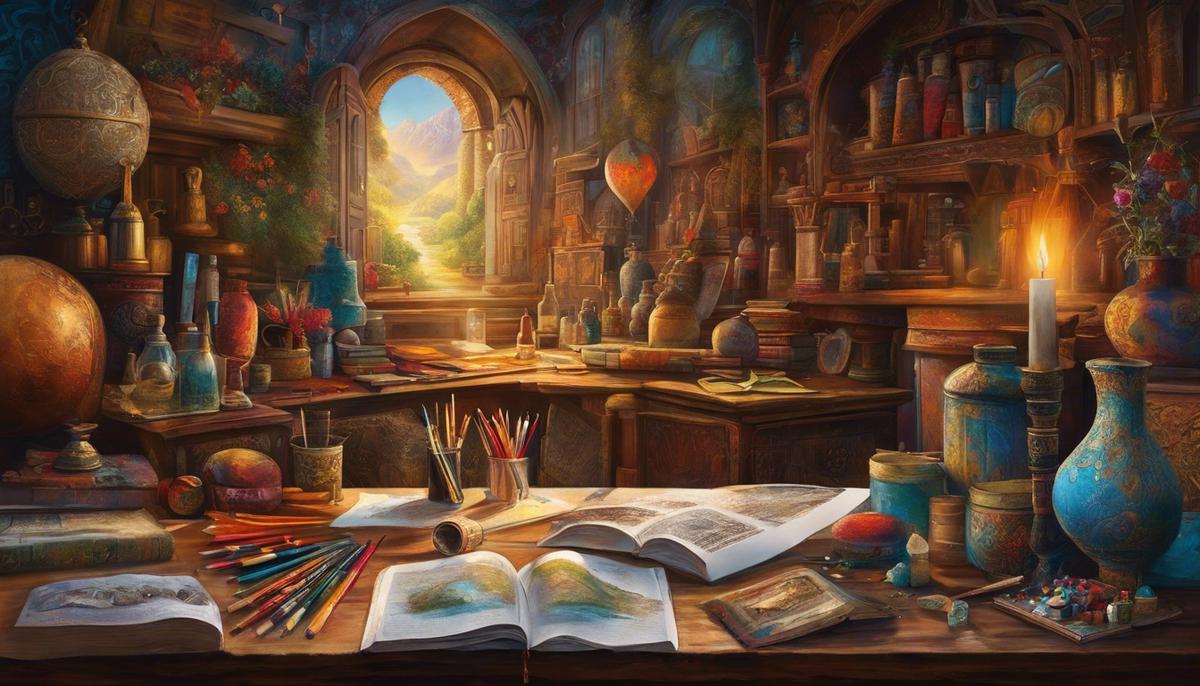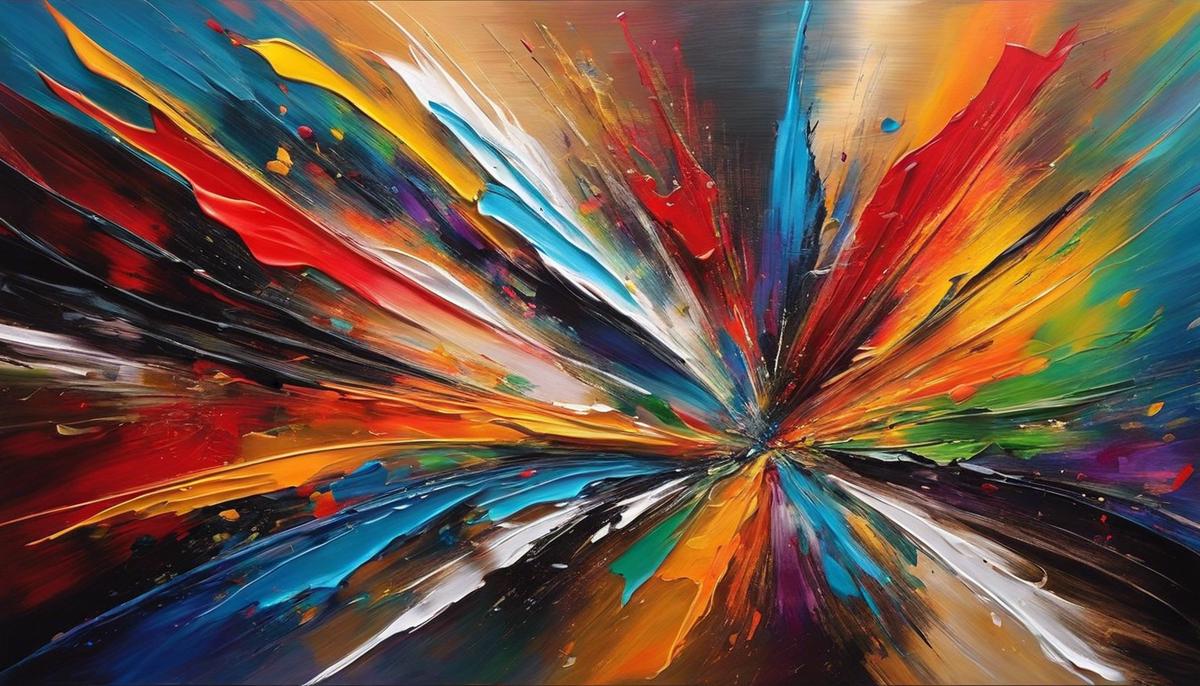Unveiling the Artistic Journey: From Creation to Exhibition
Welcome to a journey filled with color, creativity, and deep-rooted passion – the magical world of art. Artists wield a unique mirror, which reflects not just the surface, but the hidden layers of reality that unfold through their vision and perspectives. Exploring the Creative Process is a curated exhibition into the mind of the artist, their inspirations, techniques, and experiences. Next, we delve into understanding the process of Crafting Unique Art Pieces, where artists breathe life into their vision, presenting unique, one-of-kind masterpieces. The Intersection of Art and Emotion explores the intricate connection between personal emotions and art creation. Finally, we reveal how these artworks reach audiences across the globe in Exposing Art To The World. Strap in for an enthralling journey into the mesmerizing world of art.
Exploring Creative Process
Artistry Draws from the Heart: The Magic Behind the Creative Process
Every dazzling canvas and every poignant sculpture is brimming with an invisible ingredient – a spark of magic that elevates a simple piece of paper or a hunk of raw material into an embodiment of emotion, ideas, and human experience. This ingredient, this magic, is the creative process. The creative process has a semblance of a Pandora’s box. But what lies within is not chaos or calamity, but a fertile playground for imagination and exploration.
The first image that often springs to mind when considering an artist at work is of a lone individual hunched over a canvas, a riot of paints, brushes, and other materials strewn around them. But the real work begins much before this scene is set. Every journey through art begins with an idea, an experience or an emotion that can be too powerful to put into words. This becomes the seed from which the fruits of creativity blossom.
Creativity is not a straight path, but rather a meandering journey. Depending on the individual artist, the path may be steeped in quiet contemplation or marked by vibrancy and passion. Some artists claim their best ideas come to them in dreams, making sleep not a waste of time, but a direct route to inspiration. Others find mirth and motivation in nature, literature, or the mundane aspects of daily life.
Envisioning is the second step in the process where the artist breathes the first life into their idea, transforming abstract concepts into a rough mental sketch. This step can be as intuitive as a dream-like dance or as technical as defining shadows and light sources for future reference.
Next comes the actual act of creation. Dipping the brush into the crisp palette or the pen to the blank canvas is often when the magic takes its visible form. The AN artist’s personal style shows up like a signature in their work. It’s an interplay of the artist’s hand movements and their instincts – swinging between control and surrender. The artist dances with the elusive muse, the creative spirit, not leading nor being led, but existing in harmony.
Revision is a final, often understated, part of the creative process. Most of the time, an artist doesn’t weave a seamless, finished product on their first attempt. It takes a period of refinement, constant modifications and improvements, before a piece of work truly reflects their original vision.
Art is not just a record of the artist’s skill, but a reflection of their heart and soul. The creative process is, in reality, a fantasy made visible, a dream turned into truth. Next time you stand before a fine piece of art, take a moment to appreciate the immense journey the artist went through. Revel in the magic that transcends the tangible, the value beyond the canvas, a testament to human emotion and experience manifested in every brushstroke and pixel.

Crafting Unique Art Pieces
The Allure of Artistic Vision: How it Shapes Unique Masterpieces
The beauty of art lies not only in the delightful complexity of the finished product, but also in the intricate tapestry of vision, creativity, personality, and skill that binds it. An artist’s vision is the compelling force and vital backbone on which unique, evocative art pieces are constructed.
Like an invisible yet palpable pull, an artist’s vision guides them through the labyrinth of their imagination, often leading them to unexpected destinations of creative brilliance. This vision fuels the journey, like a guiding star, steering the artist to mix the perfect palette, etch the right lines, and mold raw materials into a piece that emanates with their unique signature.
The uniqueness of an artwork is directly proportionate to the artist’s visionary quality – the profound insights, fantasies, experiences, and beliefs that act as the compass directing their creativity. Each artist registers the world differently. Their perspectives on life, pain, happiness, beauty, and the universe vary dramatically. Thus, their artwork naturally becomes a mirror reflecting their remarkably unique vision.
Artistic vision, too, influences the medium and materials an artist utilizes. Some artists find their visions best depicted on canvas, others in stone or metal, and some in the digital world. It’s like a love affair between the artist, their vision, and their medium, with each influencing the other in diverse, exciting ways.
Just as a seed gradually blossoms, an artist’s creative vision evolves. It navigates through a delightful labyrinth of influence, self-discovery, and exploration. A canvas might begin as a swirl of confusion, gradually transforming into a melody of shapes, contrasts, and motifs. This transformational journey is dictated by the artist’s vision and can result in astonishingly unique masterpieces.
Just like the continuous shifts in the cosmos, an artist’s vision never truly stabilizes. It keeps evolving, as dynamic as the tides of the ocean. This flux can lead to the creation of vastly differing art pieces by the same artist. It also lengthens the spectrum of creativity, enhancing the range of pieces an artist can produce throughout their career.
In the world of art, the artist’s vision acts as the mysterious sorcerer giving life to the inanimate. It is an essential component and driving force behind the formation of art pieces that stir the viewer, tell a story and resonate on a deeper, emotional level. To glance at a piece of art is to peek into the artist’s inner universe, to witness their unique interpretation of existence or experience, illuminated by their distinct artistic vision.
In conclusion, an artist’s vision molds their interpretation of the world into a tangible form, birthing unique pieces of art. Each stroke, each chisel, each pixel is imbued with their unique vision, resulting in art that is resonant and uniquely their own. The artist’s vision, then, is truly the life force from which unique art pieces spring forth. It is the unseen seamstress weaving incredible stories and emotions onto diverse canvases, creating pieces that captivate, mystify, and dazzle us. Have you ever been fascinated by a piece of art and wondered about the vision that inspired it? Well, now you know where to start your contemplation.

The Intersection of Art and Emotion
The Intersection of Art and Emotion: Invoking Resonance with Audiences
Art is not merely an aesthetic endeavor—it oftentimes embodies an emotional exploration of the artist’s internal world, a journey meticulously translated into tangible representations. This culmination of art and emotion is a vital factor in determining whether a piece of work resonates with audiences.
Our emotions serve as our most intimate navigators throughout life, instantly compelling us towards joy, while thoughtfully steering us away from unease. This instant emotional intuition is equally crucial in the world of art, serving as a silent language that has the power to cross cultures, generations, and worlds.
As such, artists often thread emotions into their work as a means of communication, enabling audiences to connect with the artwork beyond its physical dimensions. This ability to invoke emotions is a testament to the potency of art, as it traverses the traditional boundaries of communication and evokes raw, unfettered emotions with its viewers.
Given the subjective nature of our emotional responses, the same artwork might elicit a spectrum of emotional reactions —which is the beauty of art’s intersection with human emotions. This intersection translates into a unique dialogue between the artist and the audience, with each art piece serving as a window into the array of human experiences and emotions.
Inasmuch as creating art is a profound emotional expedition for artists, perceiving art can be an equally profound emotional exploration for audiences. When confronted with a piece that reverberates with personal memories, values, or emotions, the viewer experiences a deep connection — a resonance that transcends the confinements of mere aesthetics. Furthermore, art can serve as a vessel for emotions that are difficult to articulate verbally, allowing both the creator and the audience to process complexity in a therapeutic, transformational dialogue.
Delving into the world of visual art, colors, for instance, offer a nuanced language of emotions. A vibrant palette can evoke sentiments of joy, while muted tones might cultivate a sense of calm or melancholy. Similarly, the rhythm of brushstrokes, the intensity of lighting, and the manipulation of space within a piece can trigger a variety of emotional responses. Art’s dynamic medium telegraphs emotions in diverse, evocative, and often subconscious ways.
Through sculptures, installations, and performance art, artists invite audiences to step outside their comfort zones and engage their emotions through diverse sensory experiences. These multidimensional approaches intensify the emotional resonance, as the boundaries between the audience and the artwork begin to blur.
In written or spoken word art forms like poetry or storytelling, the synergy of emotion and art manifests in a resounding echo of human experiences. The gifted storyteller can utilize language to evoke laughter, tears, outrage, or epiphanies, guiding their audience through a landscape saturated with emotions.
Ultimately, the fusion of art and emotion results in a level of vulnerability that touches the core of human connection. Art offers an intimate reflection of our collective emotional experiences, mirroring our humanity in profound strokes of empathy. It’s this amalgamation of creativity and emotional disclosure that gives artwork its power to captivate, resonate, and transform—becoming a beacon of connection, understanding, and catharsis.

Exposing Art To The World
Diving into the profound depths of art, we journey beyond mere spectators to a multidimensional realm of art discovery and interaction. As we witness an art piece, we glean a world of stories etched within the contours of the creative works – each narrating tales of the journey traversed by the artist. Thus, unveiling an art piece to the world through multiple platforms plays a pivotal role in shaping this profound bond between the audience and the creator.
At the heart of this connection is the open panorama of interpretations and insights invoked by the art piece. When art is disseminated across various platforms, it transcends geographical boundaries and cultural barriers, urging viewers far and wide to partake in this journey of deciphering the underlying anecdotes cocooned within the art. This collectively rejoiced journey metamorphoses the audience into active participants, bridging the gap between the artist and spectators, paving the way for dialogues that bear the potential to enrich human experiences.
Moreover, different platforms lend unique frames of context and perspectives to the artwork. An art exhibition in a serene, contemplative gallery space is an invitation for a profound, internal dialogue with the art. Meanwhile, the dynamic ecosystem of the internet propels an art piece into a bustling global marketplace of diverse interpretations and conversations, primed for engagement and dialogue. Equally, in the context of public spaces, art morphs into a voice echoing through communities, sparking interplay of shared experiences and collective stories.
This multidirectional exchange is not only a testament to the power of art, but also an amplification of the artist’s creative range. The varied platforms serve as sails, navigating the art piece through a sea of interpretive possibilities, fanning the embers of curiosity and awe within viewers. It gives the artwork a life beyond its physical form, enhancing its emotional resonance and narrative depth.
Furthermore, the art’s exposure to a wider audience cultivates a rich tapestry of feedback and reflection. As spectators decode the art, they weave their personal anecdotes and experiences into the narrative fabric of the artwork. This conglomerate of experiences enhances the dialogic nature of art, fostering a tool of universal language that transcends societal barriers and normative restrictions. Such interactions foster a unique relationship, creating an intimate bond between the creator and their audience.
In the openness of a wider platform, the art piece ingrained with the artist’s signature and vision, pays a tribute to diversity, reaffirming the unique beauty in the canvas of human individuality. A fusion of emotions, memories, and personal values, it captivates, mesmerizes, and resonates deeply within the human psyche, communicating with the audience in ways words often fail to.
Ergo, exposure through different platforms not only enriches the art’s narrative, but also fosters a symbiotic relationship between the creator and viewer. It transforms each art piece into an aesthetically rich crucible of interaction and connection, breathing life into the silent echo of human emotion and experience. Art, hence, unfurls as an undulating, poetic dialogue that traverses the realms of the heart and soul, transforming the creative ecosystem into a vibrant, resonating orchestra of aesthetic and emotional harmony.

From the first strokes on an empty canvas to the eventually showcased masterpieces, we have navigated the mesmerizing journey of an artist. We have dived into their brainstorming processes, understood the essence of their unique art pieces, and felt the vibrant emotions embedded in their artworks. We have also explored the various platforms used to expose their art to the world, giving us an enriching understanding of their approach to art. This introspective journey through the world of art lifts the veil, allowing us to appreciate not only the final result but the beautiful chaos and raw passion involved in creating each unique piece. Undoubtedly, every artwork holds a mirror to the artist’s soul, and through their creation, we get a glimpse of their inner universe.
